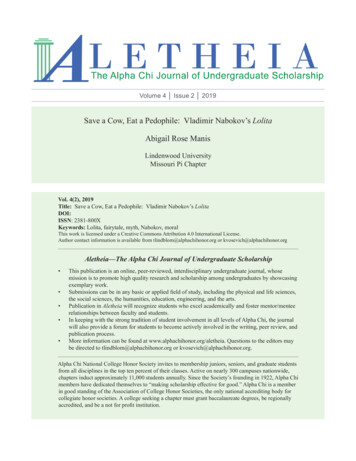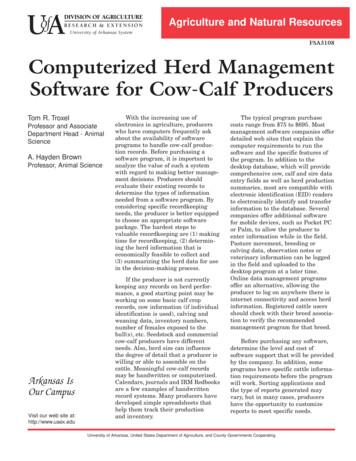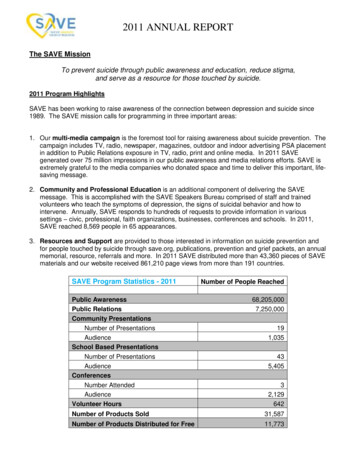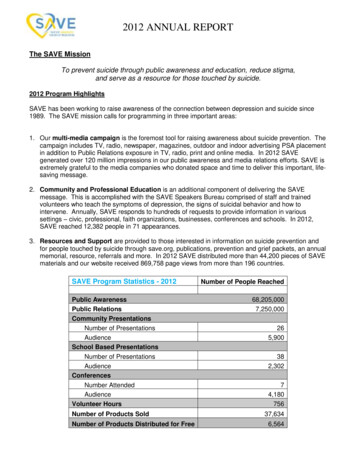
Transcription
Volume 4 Issue 2 2019Save a Cow, Eat a Pedophile: Vladimir Nabokov’s LolitaAbigail Rose ManisLindenwood UniversityMissouri Pi ChapterVol. 4(2), 2019Title: Save a Cow, Eat a Pedophile: Vladimir Nabokov’s LolitaDOI:ISSN: 2381-800XKeywords: Lolita, fairytale, myth, Nabokov, moralThis work is licensed under a Creative Commons Attribution 4.0 International License.Author contact information is available from tlindblom@alphachihonor.org or kvosevich@alphachihonor.orgAletheia—The Alpha Chi Journal of Undergraduate Scholarship This publication is an online, peer-reviewed, interdisciplinary undergraduate journal, whosemission is to promote high quality research and scholarship among undergraduates by showcasingexemplary work.Submissions can be in any basic or applied field of study, including the physical and life sciences,the social sciences, the humanities, education, engineering, and the arts.Publication in Aletheia will recognize students who excel academically and foster mentor/menteerelationships between faculty and students.In keeping with the strong tradition of student involvement in all levels of Alpha Chi, the journalwill also provide a forum for students to become actively involved in the writing, peer review, andpublication process.More information can be found at www.alphachihonor.org/aletheia. Questions to the editors maybe directed to tlindblom@alphachihonor.org or kvosevich@alphachihonor.org.Alpha Chi National College Honor Society invites to membership juniors, seniors, and graduate studentsfrom all disciplines in the top ten percent of their classes. Active on nearly 300 campuses nationwide,chapters induct approximately 11,000 students annually. Since the Society’s founding in 1922, Alpha Chimembers have dedicated themselves to “making scholarship effective for good.” Alpha Chi is a memberin good standing of the Association of College Honor Societies, the only national accrediting body forcollegiate honor societies. A college seeking a chapter must grant baccalaureate degrees, be regionallyaccredited, and be a not for profit institution.
20192Volume 4 Issue 2 2019Article Title: Save a Cow, Eat a Pedophile: Vladimir Nabokov’s LolitaDOI:ISSN: 2381-800XThis work is licensed under a Creative Commons Attribution 4.0 International License.Save a Cow, Eat a Pedophile: Vladimir Nabokov’s LolitaAbigail Rose ManisLindenwood UniversityMissouri Pi ChapterAbstractMany who read Vladimir Nabokov’s novel Lolita express negative reactions at its conclusion, such asrevulsion, anger, and outright dismissal of its highly controversial plot. However, the contents of this storyconstitute only half of its importance. The other half is the hypnotic and slippery mode in which it is told.The dual configuration of the narrator as the protagonist allows the main character to craft his own versionof the events that have taken place in his life through a demented, artistic frame.This essay argues for the interpretation of Vladimir Nabokov’s Lolita as a dark fairy tale. My argumentdraws from the fairy-tale references made in the text itself, the “othering” done by the main character toclassify his sexual prey as a mythical creature, the mirroring of the two main characters, and the unreliabilityof the manipulative, delusional narrator. I postulate that the same distortion that makes this a fairy tale alsocauses the audience to sympathize with the main character despite his crimes and conclude that novels suchas this are dangerous in their seductive, fantastical characteristics.Keywords: Lolita, fairytale, myth, Nabokov, moralVladimir Nabokov’s controversial and frequentlybanned 1955 novel Lolita explores themes such as pedophilia, impotence, and lust disguised as love (or viceversa). These topics are viewed and presented throughthe eyes of a first-person narrator, which grants the novel’s protagonist, Humbert Humbert, absolute controlover the novel’s narrative. The novel has Humbert usethis power to its fullest potential. Most names, for instance, including his own, are clearly fabricated. Someof these are subtle in their falsity. Others, such as hisown rather absurdly repetitive name of Humbert Humbert, are not. Such unreliable information, along withHumbert’s inconsistent memories and hazy distortionsof his affair with twelve-year-old Lolita, means there isno possible way to discern whether the events he describes actually happened in the way he describes themor, in fact, at all. This, along with Humbert’s completecontrol of his own story, transforms Nabokov’s Lolitainto an amoral American fairy tale. The novel uses threetactics to achieve this fantastical nature. First, Nabokovdoubles the character of the novel’s first-person narrator and protagonist, granting Humbert the opportunityto create his own delusional world. Second, Lolita includes a fantastical, sexualized “other” and relies uponmythical references and plot structure, which includesa nonlinear and whimsical presentation of time. The final, third tactic deploys a curious mirror imagery thatthe novel tends towards as a product of Humbert’s psychopathy, to the point that the structure of the novel evenreflects the trend.The story of Lolita appears in the form of a manifesto narrated by Humbert Humbert, a middle-aged convict who has a sexual obsession with a sect of preteengirls he dubs “nymphets” (Nabokov 16). This obses-
2019Aletheia—The Alpha Chi Journal of Undergraduate Researchsion leads him to kidnap and engage in a violent affairwith one such girl named Dolores Haze or, as he namesher, Lolita. Humbert sets the story of their destructiverelationship against a quaint, car-obsessed Americancultural landscape filled with obstacles to one man’ssingle-minded quest for sexual fulfillment. For the sakeof clarity, I will now define a “nymphet” in the eyes ofH.H. (Humbert Humbert). According to the narrator, anymphet is a girl between the ages of 9 and 14 with a“fey grace, [an] elusive, shifty, soul-shattering, insidiouscharm that separates the nymphet from such coevals ofhers” (Nabokov 17). H.H. insists nymphets are not normal girls. In fact, Humbert refers to them in the novelwith demonic and fantastical words and phrases morethan several times in order to categorize these girls assomehow other-than-human. Normal girls, as he says,are human children, and he would never molest a child.In his mind and in his story, however, nymphets are notlike human girls. It is thus acceptable to think of them asdiaphanous agents of pleasure and mischief (Nabokov17). It is easy to see evidenced in the text that Humbert“others” these children to justify his own perverted sexual appetites. He does this by categorizing their attractiveness to him as otherworldly temptations by demonicand supernatural forces out of his control, rather thanas an unhealthy fetish for uninhibited prepubescent children who are unable to hide from (or are simply not fullycognizant of) the adult male gaze. This delusion of magic and sorcery allows the narrator to manipulate readersinto suspensions of disbelief as he begins to present thenovel’s plot as might a fairy tale with rules and speciesunfamiliar to human reality.One explanation for his delusion and predation isencapsulated in the way H.H. sees himself. Numeroustimes throughout the novel, he refers to himself as amonster, a beast, a spider, or a madman. This malevolence, according to H.H, is what allows him and otherslike him to distinguish nymphets from ordinary humangirls:You have to be an artist and a madman with abubble of hot poison in your loins in order to discern at once, by ineffable signs the little deadlydemon among the wholesome children; she standsunrecognized by them and unconscious herself ofher fantastic power. (Nabokov 17)In this case, like recognizes like, and his view ofhimself as a corrupted individual convinces Humbertthat what he sees is indeed the truth and not simply a3twisted perception. It is, therefore, not too far of a leapto conclude that he sees the girls as nefarious beings ofthe same sort as he, even if, as he says, they are “unconscious of [their] fantastic power.” H.H. is convincedthat like attracts like (or, perhaps, H.H. wants to convince the readers), and his own self-hatred combineswith his intense narcissism to cause the delusion that heis seeing something no one else except those like him,“artists,” can see.Humbert’s delusions are further evidenced by thedoubling prominent in Lolita. There are, for example,two Humberts. There is the Humbert who is in the pastperforming the actions he describes in the story and theHumbert of the novel’s present who is writing what hewants to be seen as a manifesto. His doubled identity ishinted at in his name—Humbert Humbert. He reflectshimself. Humbert provides readers with obvious insightsabout how exactly he wishes to be seen. Humbert refersto himself as Lolita’s protector (Nabokov 121), for example, only to then describe himself and his pathological sensuality as a “great and insane monster” (Nabokov124). This duality or pair of opposites is one of the manyseduction techniques Humbert uses to sway his reader’sheart and mind. The protagonist is certainly a madman,but he is also an artist. As he narrates, Humbert admitsthat he is writing something more than a mere manifestowhen he implores readers not to get impatient with the“tenderhearted, morbidly sensitive, infinitely circumspect hero of [his] book” (Nabokov 129). In this way,his narration mirrors more conventional autobiographiesand memoirs because in these texts, like in the fictionalLolita, narrators tell their stories through the prisms oftheir present states of mind. There is no other way to interpret the past; it is impossible to exactly replicate one’spast reactions. However, adding H.H.’s insanity to thispast-present dynamic, it should come as no surprise thatLolita becomes a fantastical interpretation rather than atrue account. In fact, H.H. distinguishes his work froman autobiography the moment he identifies his past selfas a hero starring in a book. Humbert’s narcissism is inescapable; though sometimes a hero, and sometimes amonster, he imbues himself with a sense of red-bloodedvirility and purpose of action much closer to the heroicdeeds of mythical and fantastical beings than the veryhuman characters described by autobiographers.As well as the existence of two Humberts, there arealso two Lolitas in Nabokov’s novel: the titular character refers most directly to Dolores Haze, but there is also
2019LolitaAnnabel Leigh, Humbert’s young summer love beforeher untimely death the same year of their fling. Annabel’s existence, however, is not a narrative fact, arguescritics such as Daniel Thomieres. In his essay, “CherchezLa Femme: Who Really Was Annabel Leigh?” Thomieres backs up this interesting claim by pointing out theinversion of Annabel’s story. We learn about her death inChapter 3, yet it isn’t until Chapter 4 that we are grantedinformation about their love affair. This is because, asThomieres argues, Chapter 3 is reality, while Chapter4 is H.H.’s fantasy about a half-remembered childhoodsweetheart who, like Dolores, was merely an object overwhich Humbert exerted his control. In a similar way,which lends itself to the final point I will address later,the end of the events of Lolita is when the book beginsto be written with fantastical flourishes similar to thosein Chapter 4 discussing his love affair with Annabel. Weare given textual evidence to back up Thomieres whenthe novel’s imprisoned Humbert laments to an absentLolita that now he only has “words to play with,” implying that, if she were to be with him in the room, he couldbe “playing” with her body instead (Nabokov 32).In addition to the novel’s fantastical “others” andthe doubling of characters such as Lolita and H.H.,Nabokov’s narrative is characterized by a whimsicalsense of time and space. This whimsy, paired with thenovel’s vulgar and grim plot, calls to mind fairytalessuch as those collected by the brothers Grimm. UnlikeGrimm’s stories, however, Lolita is abjectly disconcerting and continues to be controversial because, whilepresenting disturbing and criminal events, it does notoffer a moral. In “On a Book Entitled Lolita,” Nabokovis quite honest about Lolita having no moral and emphasizes that he is “neither a reader nor a writer of didacticfiction” (314). According to him, fiction survives onlyas long as it provides “aesthetic bliss,” which, if the extensive scholarship on the novel and a Stanley Kubrickmovie adaptation of it are of any indication, is, at thevery least, nominally accurate of Lolita (Nabokov 315).One of the best examples of Nabokov’s “aesthetic bliss”is the entire middle portion of the novel. This sectionconsists of a series of chapters that appear almost as anintermission to the plot because here readers are treatedto a rush of quaint 1950s nostalgia made up of flashy Coca-Cola signs, rest stops, pink flamingo motels, and thelike. Just like the roadside attractions, which can keeprestless drivers entertained, H.H. struggles to keep Lolita distracted by movies, comics, ice cream, and dresses,4and there is little mention of what is obviously goingon every morning and night—the rape of Dolores. Thisgrim reality is left out of the story as readers are distracted by the “aesthetic bliss” of the American roadside.Despite the absence of any moral lessons, the novel’s characters and their actions recall many popularfairy tale archetypes. For instance, Humbert Humbert isat one time the embodiment of a prince charming because he saves Dolores from her “wicked” stepmother.At other points in the novel, however, he also becomesthe evil, jealous stepfather, and at others still, the enchanted hunter who stalks his nymphet prey. Similarly, Dolores changes roles or functions, though it is important to remember that her appearance, behavior, andwords are only shown through the unreliable and biasedtestimony of a murderous narcissist. Through the c
Save a Cow, Eat a Pedophile: Vladimir Nabokov’s Lolita Abigail Rose Manis Lindenwood University Missouri Pi Chapter. 2019 2 Vladimir Nabokov’s controversial and frequently banned 1955 novel Lolita explores themes such as pe-dophilia, impotence, and lust disguised as love (or vice versa). These topics are viewed and presented through the eyes of a first-person narrator, which grants the nov .











